

 The Devon & Exeter Hospital in Southernhay was built well before the coming of the motor car and the use of this Traffic Sign – remembered by some of us of a certain age - which depicts the Maltese Cross of the Knights Hospitallers of St John; the symbol is still used to this day by the The St John Ambulance charity.
The Devon & Exeter Hospital in Southernhay was built well before the coming of the motor car and the use of this Traffic Sign – remembered by some of us of a certain age - which depicts the Maltese Cross of the Knights Hospitallers of St John; the symbol is still used to this day by the The St John Ambulance charity.
This page does not give a history of the hospital but does cover times when it was in use as such, including the period when, after the visit by the Duke and Duchess of York in 1899, it became the Royal Devon & Exeter Hospital and survived in Southernhay until 1974 when closure occurred as its facilities were deemed inadequate for the demands being placed on it, and it relocated. The complete history can easily be sourced on line and in J.D. Harris’s. ‘The Royal Devon and Exeter Hospital, Exeter’ published by Eland Brothers.
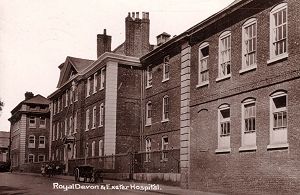 What this page does cover is the involvement of the Company with Boilers, Heating and Hot water and specifically Kitchen facilities for the ‘new’ kitchens in 1895. It is extremely likely that the whole heating and hot water pipework was installed at the same time as the two coal fired Boilers were set in place and put into operation in the Boiler House. There is documentation that radiators were installed by the company in the Newcourt Ward in 1910 and the contract document still exists. What this page also shows are views within part of the original hospital buildings after the NHS had moved out which were photographed by me in 2004 (with permission!), and they give an idea of the somewhat ramshackle state the hospital had become as bits and pieces were ‘modernised’ whilst older facilities and equipment often remained untouched.
What this page does cover is the involvement of the Company with Boilers, Heating and Hot water and specifically Kitchen facilities for the ‘new’ kitchens in 1895. It is extremely likely that the whole heating and hot water pipework was installed at the same time as the two coal fired Boilers were set in place and put into operation in the Boiler House. There is documentation that radiators were installed by the company in the Newcourt Ward in 1910 and the contract document still exists. What this page also shows are views within part of the original hospital buildings after the NHS had moved out which were photographed by me in 2004 (with permission!), and they give an idea of the somewhat ramshackle state the hospital had become as bits and pieces were ‘modernised’ whilst older facilities and equipment often remained untouched.
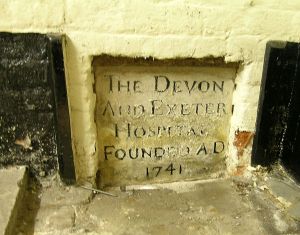 We start off with the Foundation stone and the Weathervane. From the depths of the basement to the highest point on the roof. The Foundation stone is found in the basement level, showing that it was laid at the beginning of construction in 1741.
We start off with the Foundation stone and the Weathervane. From the depths of the basement to the highest point on the roof. The Foundation stone is found in the basement level, showing that it was laid at the beginning of construction in 1741.
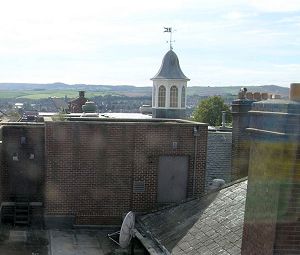 Maybe the weathervane was one of the Company’s fabrications? – who knows, it seems to suggest that it took a year before the building was completed and it was then put in place on top of the cupola – that is the architectural definition as opposed to the other definition that is so relevant to Garton & King and its foundry, where a ‘Cupola’ is a melting device used in Foundries.
Maybe the weathervane was one of the Company’s fabrications? – who knows, it seems to suggest that it took a year before the building was completed and it was then put in place on top of the cupola – that is the architectural definition as opposed to the other definition that is so relevant to Garton & King and its foundry, where a ‘Cupola’ is a melting device used in Foundries.
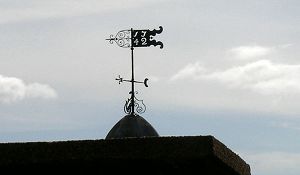 The date on the Weathervane is 1742. I have reversed the image so the date, on enlargement of the image can be read more easily.
The date on the Weathervane is 1742. I have reversed the image so the date, on enlargement of the image can be read more easily.
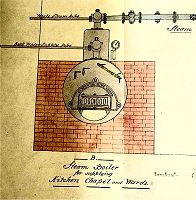 Perhaps the best place to start off with regards to Heating and Hot Wate is the source and here we have three images, all unfortunately undated, of the coal fired boilers installed in the Hospital in the basement.
Perhaps the best place to start off with regards to Heating and Hot Wate is the source and here we have three images, all unfortunately undated, of the coal fired boilers installed in the Hospital in the basement.
First a scale drawing of a similar boiler to those installed in the hospital.
The left image below shows the pair of large boilers that ultimately were installed in the Boiler House at the old Devon & Exeter Hospital in Southernhay. The Inscriptions on the Distribution Panel above the boilers on the large diameter pipework and below the Valve Wheels read: ‘Return Distribution Box’ and ‘Halford, Bowring, Halford, Cold Feed and Chapel’ The is a similar Distribution Box behind for the ‘Flow.’
The second image (above right) shows the rear of the pair of boilers from the other end, where the ash and cinders are raked out.
One cannot help but note the array of large diameter pipework heading off in all directions. Even in 2004 the maze of pipework, of all diameters, mainly internal, but also external, such as soil pipes & downpipes was very apparent. The boilers were probably installed in 1900 or before, unfortunately no documentation confirming exactly when this was has yet come to light.
In 2004 wherever I went, within or outside the building there was an amazing array of heating and water supply pipework, some lead as in the second image, some cast iron and more modern copper.
There were radiators everywhere, 90% of them cast iron and by ‘Ideal’ or the ‘American Radiator Company’. In the unidentified ward pictured below there were in excess of twenty. Some had already been removed from elsewhere within the building and were set aside outside the premises (they have a definite market value nowadays, even second hand).
It is more than possible the original installation of the heating system throughout the original hospital buildings was carried out by the Company. Certainly on the 11th November 1910 the Royal (as it had become) Devon & Exeter Hospital instructed Garton & King to undertake the following work was on the Heating System in the Newcourt Wards.
‘Supply fix and connect six additional sections to each of the eight Hot Water Radiators in the ‘Newcourt’ Wards. Three sections to be placed either side of each existing Radiator, the flow & return connected to each new radiator. The new sections to be of the ‘Peerless’ 3 column type by the National Radiator Company., 32” high giving a heating surface of 13½ square feet per three sections.’
Directions continued as to the radiator carriers and as to how the new and old sections were to be joined and the end result to be level. A 1” gunmetal Valve, type Ideal No 110 to be fitted to the flow side of each radiator in place of the existing plug valve, and the old valves and fittings to remain ‘the property of the Hospital’.
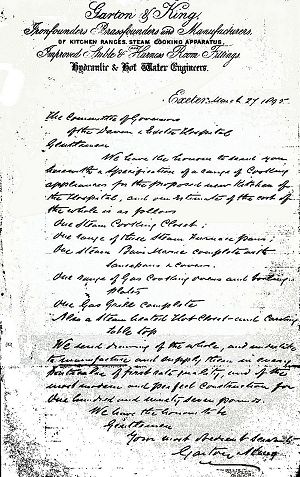 Not a stone, it seems, was left unturned, including I might add, the requirement for a ‘2 year Guarantee on the work’, which had to be done ‘as soon as possible’ and ‘to the satisfaction of the Committee of the Royal Devon & Exeter Hospital’.
Not a stone, it seems, was left unturned, including I might add, the requirement for a ‘2 year Guarantee on the work’, which had to be done ‘as soon as possible’ and ‘to the satisfaction of the Committee of the Royal Devon & Exeter Hospital’.
The Company were required to sign a Memorandum of Agreement that, as you might have guessed already, protected the Hospital Committe against all possible eventualities.
On March 27th 1895, presumably on the request of the previously mentioned Committee of Governors of the then Devon & Exeter Hospital, a letter was sent to them by the Company listing various items of Kitchen Equipment that the Company could provide and presumably the Company predicted might be beneficial to the ‘proposed new Kitchen of the Hospital, and the estimated cost of provision. The items listed were:-
One Steam Cooking Closet.
One range of three Steam Furnace Pans.
One Steam Bain Marie complete with Saucepans and Covers.
One range of Gas Cooking Ovens and Boiling Plates.
One Gas Grill complete.
Steam Heated Hot Closet and Carving Table Top.
The letter goes on to state that the Company would ‘Undertake to manufacture and supply them in every particular of first rate quality and of the most modern and perfect construction for One Hundred and Ninety Seven Pounds’.
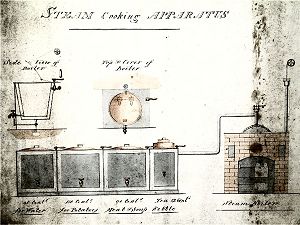 The next two pages of the letter go on to describe the items listed above in some detail including measurements and finish, and emphasise that Steam Apparatus would be tested at the works to a pressure of 40lbs per square inch. The range of cooking appliances would be ‘Japanned in any desired colour and finished in the best manner’. All this would be done at the Company’s Works in Waterbeer Street. Was this quotation accepted I wonder? I have yet to find out. There are drawings in the archives that may well depict similar appliances to that described so I have included them to give the reader an idea as to what they may have looked like.
The next two pages of the letter go on to describe the items listed above in some detail including measurements and finish, and emphasise that Steam Apparatus would be tested at the works to a pressure of 40lbs per square inch. The range of cooking appliances would be ‘Japanned in any desired colour and finished in the best manner’. All this would be done at the Company’s Works in Waterbeer Street. Was this quotation accepted I wonder? I have yet to find out. There are drawings in the archives that may well depict similar appliances to that described so I have included them to give the reader an idea as to what they may have looked like.
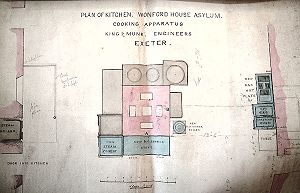
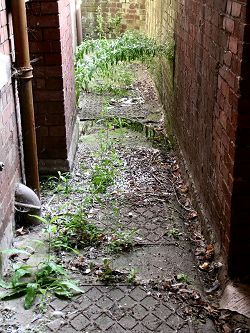 King & Munk came into being in 1883, some dozen or less years before the quotation for the Kitchen Equipment was written and sent to the Committee at the Devon & Exeter, but it is likely that the New Kitchen at the Devon & Exeter Hospital shared something in common with this image (right) which shows that the Company also equipped the Kitchen at the Wonford House Asylum. The plan would have been drawn between January 1883 and June 1885 at the latest.
King & Munk came into being in 1883, some dozen or less years before the quotation for the Kitchen Equipment was written and sent to the Committee at the Devon & Exeter, but it is likely that the New Kitchen at the Devon & Exeter Hospital shared something in common with this image (right) which shows that the Company also equipped the Kitchen at the Wonford House Asylum. The plan would have been drawn between January 1883 and June 1885 at the latest.
Back to the Devon & Exeter. In addition to everything mentioned so far it is also worthy of note that all the manhole covers in the vicinity of the hospital building complex were made by Garton & King and date from prior to 1925. Some of them are almost inaccessible so you will have to take my word for this. These shown here (right) in a row probably allowed access to the Coal Cellars adjacent to the Boiler House. The diamond pattern is unusual, the wording in a Times style font reads ‘Garton & King, Exeter.’ In the pavement outside the building we find this example (below) that describes the Company as ‘Garton & King, Engineers, Exeter’
Click on the image below to see a slideshow of photos showing the Hospital as I found it when I was allowed to wander freely within the empty building in 2004. A somewhat odd experience when I was the only person in the whole of the building, a far cry from its time in use with abundance of staff and indeed patients.
Top of page
May 2023
See also:
King & Munk — Power to the Pumps
Heating Equipment — Cooking Equipment
Hothouse Heating — Testimonials and Recommendations
Sitemap / Contents